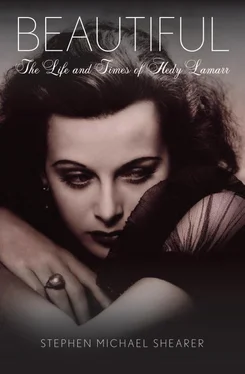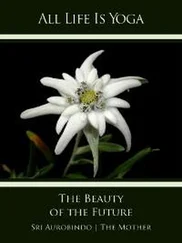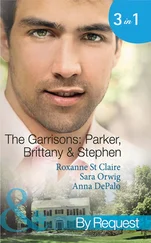Completed in early 1931, Sturm im Wasserglas was also directed by Georg Jacoby. Felix Salten, author of the children’s classic Bambi , wrote the film’s dialogue. It premiered on April 21, 1931, at the UFA–Theater Universum on Lehniner Plaza in Berlin. Sturm im Wasserglas was a popular hit in Europe. When it opened at the Little Carnegie Playhouse in New York on July 7, 1932, critics praised the film. Hedy Kiesler was not mentioned in any of the reviews, and she was discouraged that leading roles would not come her way.
Hedy’s parents began to encourage her to study her chosen craft, and she realized that she should take her career seriously. It was a wise move that would ultimately change her life, for now Hedy wanted to study in Berlin. Yet there were possibly other forces that influenced her decision to leave home, which was ultimately fraught with tragedy.
While she was still attending school in Vienna in 1930, she went on a hiking trip in the Swiss Alps with her classmates and met a handsome young Austrian officer, Ritter Franz von Hochestetten, a nobleman and scion of a wealthy, prominent Bavarian family. 48The couple began seeing each other, and the sensitive young man pleaded with Hedy to marry him. They became engaged. But Hedy refused to relinquish her dreams of becoming a film actress. After a heated argument one evening, Hedy broke off the engagement, and, according to later accounts, the young man returned to his home and killed himself. 49
Devastated by this, Hedy concentrated her energies on her ambitions. Because of her work at Sascha-Tobis-Film and her association with Alexis Granowsky, Hedy petitioned the director for an introduction to the Deutsches Theater in Berlin, where she hoped to perform. She was determined to study drama with the already legendary theatrical producer Max Reinhardt at his school in Berlin. Gaining her parents’ financial support, she left for Germany. (She did not receive a graduating diploma from the academy in Vienna.)
Arriving in Berlin during the fall of 1930 with the sole purpose of breaking into theater, Hedy soon realized that it would not be easy. Though she was enrolled in the energetic and competitive Max Reinhardt School, Hedy made no headway in achieving her dreams of stardom. “All German actors wanted to work for Reinhardt,” writes Scott Eyman in his biography of Ernst Lubitsch, “[w]hich meant that just getting an audition was extraordinarily difficult. For a young [person] whose only stage experience was in school plays, it was impossible.” 50But not entirely impossible for Hedy.
She dutifully attended classes. Her two most influential instructors at the Reinhardt School were Professor Ernst Arndt and Dr. Stephan Hock. Hedy applied herself to her studies and was rewarded. Her two professors helped her gain entry into a rehearsal of a play Reinhardt was preparing to mount, the French dramatist Édouard Bourdet’s social satire, The Weaker Sex ( Le sexe faible ).
Reinhardt’s protégé, the future film director Otto Preminger, recalls his first meeting with the young Hedy Kiesler. “One afternoon I was sitting in my office,” Preminger wrote in his autobiography, “[M]y secretary, Miss Holmann, brought in a girl with a letter of introduction from a friend of mine, the Hungarian playwright Geza Hereczeg. The girl told me shyly that her name was Hedwig Kiesler, that she was called Hedy, that she was seventeen and wanted to act. I took her downstairs to the stage to meet Reinhardt.” 51Dressed in a trench coat and carrying her schoolbooks, Hedy looked even younger than she actually was.
Leading her by the arm, Preminger escorted Hedy down to the theatre auditorium, offered her an empty seat, and departed. Reinhardt was pacing back and forth across the stage, his hands clasped behind his back. Unfortunately for her, Reinhardt hated to have people watching his rehearsals. When he noticed Hedy sitting in the back of the theatre alone, he called her on the stage. “I just wanted to watch a rehearsal,” Hedy recalled telling him. “I watched one in Salzburg, and I watched The Dying Swan , and I would like to see you direct, if you don’t mind.” 52In 1933 she told a reporter what happened next: “‘My name is Reinhardt’ [he told me], and I answered, ‘And mine is Kiesler.’ ‘Do you speak English?’ he asked, and I answered in the affirmative. And I got a small part in Das schwächere Geschlecht .” 53
Taken with her obvious beauty and her fearless determination, Reinhardt cast Hedy in the small role of “2nd American Girl” in Das schwächere Geschlecht ( The Weaker Sex ). Hedy opened and performed the role briefly in Berlin. Reinhardt then abruptly left Germany to stage the production in Vienna. Hedy was frustrated because she had such a small part. She would write home to her parents to let them know how happy she was to be working as an actress. But often she would suggest that she was lonely.
Berlin at this time was teeming with nightlife, glittering beer halls and watering holes such as the Café am Zoo. Hedy reveled in this nightlife, and she began dating again. Her new beau was Count Blücher von Wahlstatt, a descendant of a famous Prussian officer who had fought opposite Napoleon’s army. In 1931, not long after meeting each other, they announced their engagement. Wahlstatt too began suggesting that Hedy give up her fledgling acting career, and soon enough she broke off the engagement.
Neither romance nor her career seemed to be working out. As she would do so many times in her life, Hedy chose to make a clean break of it. Torn between remaining in Berlin and continuing her studies, she chose to follow her famed director and her ambitions to Vienna, back to her family, back to her roots.
2

Reinhardt
The theatrical impresario Max Reinhardt was born Max Goldmann in 1873 in the Austrian city of Baden, the son of poor Jewish parents. Raised in Vienna, he received his theatrical training at the Sulkowsky Theater in Matzleinsdorf. In 1893, he was hired as assistant director by the Stadtheater in Salzburg, and the following year he moved on to the Deutsches Theater in Berlin. Over the next several years, he successfully introduced a new style of dramatic acting that used a more simplified and naturalistic approach to performance than the declamatory style so prevalent in the nineteenth century.
By 1905 Reinhardt managed the Kleines Theater (Small Theater) and Neues Theater (now the Berliner Ensemble) in Berlin, where he staged a spectacular production of William Shakespeare’s A Midsummer Night’s Dream . Following World War I in 1920, along with Richard Strauss and the playwright Hugo von Hoffmannsthal, Reinhardt revived the Salzburg Festival. The Salzburg Festival was begun in 1877 and discontinued in 1910. It was a five-week summer celebration of music and drama held annually in Salzburg, Austria, the birthplace of Wolfgang Amadeus Mozart.
Influenced strongly by the theatrical works of the playwright August Strindberg and by the operatic ideal of Richard Wagner, Reinhardt believed in theatre as spectacle, in the elaborate use of staging and set design to achieve dramatic impact with minimal stage effects. He taught his students that exceptional acting was the most important element of theatre and that the actor was only as good as his or her knowledge of all aspects of stagecraft. This maxim led to Reinhardt’s reputation as a master of stage direction.
“When Reinhardt’s method of production worked, the play was the star; when it didn’t, Reinhardt was the star, one eminently worth watching,” wrote the biographer Scott Eyman. 1Reinhardt was called on in 1929 to establish a drama seminar in Vienna, which was initially taught at the Schönbrunner Schlosstheater, the imperial theatre in Schönbrunn Palace. It was called the Max Reinhardt Seminar, an academy for theatrical training.
Читать дальше
Конец ознакомительного отрывка
Купить книгу













